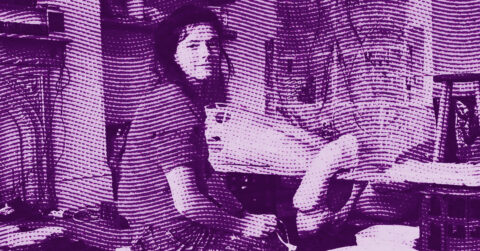Listen to me carefully, you bunch of snobs. While you keep marveling again and again in front of conceptual canvases still devoid of meaning, a truly exceptional artist transforms figurative painting into an arsenal of devastating power. Nicole Eisenman, this French-American living in Brooklyn, does not just paint bodies. She dissects the human soul with the precision of a Freudian surgeon and the brutality of a Berlin expressionist from the twenties.
Born in 1965 in Verdun, daughter of an American military psychiatrist, Eisenman grew up in the shadow of psychoanalysis before conquering the New York avant-garde of the nineties [1]. Today, her major exhibitions travel the world, from Chicago to London to Munich, confirming her status as a major artist of her generation [2]. But behind this institutional recognition lies a work of troubling complexity, nourished by two apparently contradictory legacies that yet form the pillars of her artistic vision.
The first of these legacies has its roots in Eisenman’s family universe. Her father, a Freudian psychiatrist, gave her from childhood the keys to decoding the human unconscious. This psychoanalytic imprint irrigates all her work, turning each canvas into a session of collective analysis. Just as Freud explored the labyrinths of the psyche through the interpretation of dreams, Eisenman probes the forbidden territories of our repressed drives. Her characters, often with distorted faces and swollen bodies, seem to come directly from our primitive id, that wild instance that civilization relentlessly tries to domesticate.
The artist does not merely illustrate Freudian theories. She updates them, confronts them with contemporary neuroses. In her paintings of crowds, those human assemblies reminiscent of German beer gardens, those open-air breweries, each figure carries within her the weight of unresolved traumas. Freudian repression becomes a plastic principle for Eisenman. Her characters desperately try to mask their anxieties under fixed smiles or artificial postures, but the painting invariably reveals what consciousness refuses to admit.
The paternal influence does not stop at psychoanalytic concepts. It shapes Eisenman’s very method. Just as her father analyzed his patients’ dreams, she dissects the collective fantasies of our time. Her self-portraits function as pictorial self-analyses, exploring her own shadow zones without complacency. This introspective approach, inherited from the psychoanalytic tradition, gives her art a rare authenticity in the contemporary artistic landscape.
Psychoanalysis in Eisenman is not just a cultural reference. It is a true creative tool, a lens through which she reveals the unconscious mechanisms governing our behaviors. Her group scenes, whether depicting political demonstrations or social gatherings, unveil the primitive drives expressed beneath the veneer of civilization. Freudian Eros and Thanatos permeate her compositions, creating a constant tension between the desire to live and the drive toward death.
This psychoanalytic approach finds a particularly powerful echo in her series of sculptures. These plaster and bronze figures, deliberately deformed in shape, evoke the hysterical symptoms Freud described in his patients at the Salpêtrière. They materialize the unconscious, giving form to repressed fantasies. Each sculpture thus becomes a plastic symptom, a crystallization of contemporary neuroses.
Eisenman’s psychoanalytic legacy is also revealed in her conception of time. Just as Freud demonstrated that the past continues to act on the present through mechanisms of repression, the artist brings together different temporalities in her paintings. Her references to ancient art coexist with ultra-contemporary elements, creating a temporal testimony that evokes the workings of unconscious memory.
This psychoanalytic dimension of her work is complemented by a second legacy: that of German Expressionism and the New Objectivity. While Freud provides her the conceptual tools to explore the human soul, the German painters of the early 20th century offer the visual language to materialize this exploration. Otto Dix, George Grosz, Max Beckmann, these artists who endured the horrors of World War I before depicting the decadence of the Weimar Republic, are Eisenman’s true masters.
Like the protagonists of the New Objectivity, Eisenman rejects idealization. Her brutal realism, devoid of any aesthetic indulgence, reveals the raw truth of our condition. Her characters, with coarse features and vulgar attitudes, recall the prostitutes and corrupt bourgeoisie that Dix painted in 1920s Berlin. This aesthetic of embraced ugliness becomes for her a political manifesto, a denouncement of social hypocrisy.
Grosz’s influence is particularly evident in her recent series of political paintings. Her depictions of demonstrations against police violence draw directly from the social commitment of the Berlin artist. Just as Grosz denounced Prussian militarism and the decadent bourgeoisie, Eisenman points out the dysfunctions of contemporary American society. Her painting becomes an act of resistance, a weapon against injustice.
Eisenman’s technique also borrows from the German masters their obsessive precision. Like Dix in his ruthless portraits, she perfectly masters the art of revealing detail. Every wrinkle, every swelling, every physical imperfection becomes meaningful. This meticulous attention to the particular, inherited from the New Objectivity, allows her to construct an uncompromising portrait of our time.
Eisenman’s use of color also reveals this German lineage. Her often acidic tones, sickly greens, and bilious yellows evoke the palette of Beckmann or Grosz. This chromatic nausea plastically translates the existential malaise permeating her compositions. Color becomes a symptom, revealing a world in decomposition.
But Eisenman does not merely replicate the formulas of her German predecessors. She updates them, confronting them with contemporary realities. Where Dix painted the war invalids of Weimar Germany, she portrays the forgotten victims of American capitalism. Where Grosz caricatured war profiteers, she targets the speculators of Wall Street. This temporal and geographical transposition attests to her ability to make artistic heritage engage with the urgencies of the present.
The satirical spirit of the New Objectivity permeates all her recent work. Her caricatures of collectors, her fierce portraits of the New York art scene continue the tradition of social critique initiated by the Berlin artists. This satirical dimension allows her to maintain an ironic distance from her own success, avoiding the pitfalls of complacency.
Eisenman’s formal brutality, inherited from German Expressionism, also serves her political vision. Her anatomical distortions are not merely stylistic exercises. They plastically express the social deformities produced by the capitalist system. Her grotesque bodies become metaphors for sick social bodies.
Eisenman’s political commitment, notably her support for the Palestinian cause, is part of this tradition of engaged German art [3]. Just as the New Objectivity artists confronted the rise of Nazism, she confronts contemporary authoritarian drift. Her art becomes resistance, her painting a manifesto.
This synthesis between psychoanalytic heritage and the German expressionist tradition gives Eisenman’s work its uniqueness in the contemporary artistic landscape. Where others settle for superficial references, she constructs a real archaeology of Western art, unearthing the underground currents that continue to irrigate our modernity. Her painting functions like a chemical developer, making apparent the deep structures that organize our relationship to the world.
The urgent relevance of her work lies precisely in this ability to synthesize. By combining Freudian psychological acuity and the critical virulence of the German avant-garde, Eisenman produces truly contemporary art, capable of grasping the transformations of our time. Her canvases function as X-rays of the collective soul, revealing the secret pathologies of our societies.
This dual lineage also explains the fascination her work exerts on new generations of artists. In an artistic context often dominated by superficiality and fashion effects, Eisenman offers a demanding alternative, nourished by culture and commitment. Her painting demonstrates that it is still possible to create art that is both scholarly and popular, sophisticated and accessible.
The institutional recognition Eisenman enjoys today must not overshadow the fundamental radicalism of her artistic project [4]. By updating the heritage of psychoanalysis and German expressionism, she offers a scathing reading of our modernity. Her art does not console; it reveals. It does not reassure; it unsettles. In a world saturated with consensual images, this uncompromising stance is her greatest quality.
Eisenman belongs to that lineage of artists who reject ease, who prefer the discomfort of truth over the comfort of illusion. Heir to Freud and Dix, she continues to explore the dark territories of the human condition. Her brush becomes a scalpel, her palette a developer. In the often deafening concert of contemporary art, her singular voice deserves to be heard. Because beyond fashion and controversy, Nicole Eisenman offers us the essential: an uncompromising mirror of who we really are.
- Official website of the Anton Kern gallery, exhibitions of Nicole Eisenman
- Museum of Contemporary Art Chicago, exhibition “Nicole Eisenman : What Happened”
- Hauser & Wirth, biography and exhibitions of Nicole Eisenman
- Whitechapel Gallery, retrospective “Nicole Eisenman : What Happened”
















